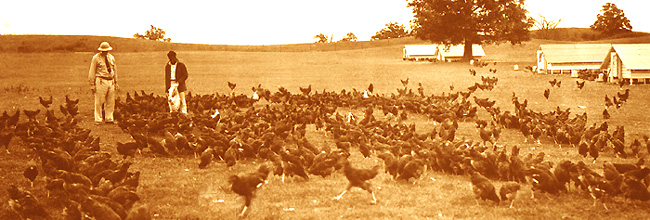|
In his The Rikers: Their Island, Homes, Cemetery and Early Genealogy in Queens County, NY, Edgar Alan Nutt writes:
From his farm [in Newtown, Queens County] Abraham Rycken could look out across the mile of Bowery Bay between the Long Island shore and the small island that became Riker’s Island. For some reason the island was attractive to him, and on August 19, 1664, he obtained a patent for it from Director General Peter Stuyvesant . . . The patent specifies
XXX
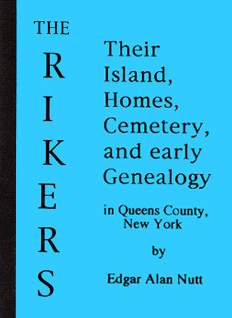
XXX
|
|
Cover of Edgar Alan Nutt's book.
|
| "a small island lying beyond Hellgate, named Hulett’s Island, north of the farm of the poor (i.e., 'de Armen Bouwerie' or the Poor Bowery), with the valley or meadow thereunto annext, which valley contained three morgen and two hundred rods."
Abraham Rycken received a confirmation [by the English] of his earlier [Dutch] patent . . . on December 24, 1667, Governor General Richard Nicolls ratified that patent specifying
"a certain small island, lying and being without Hell-gate, to the North of poores Bowery, commonly called and knowne by the name of Huletts Island, with the Meadow Ground or Valley annext; which said Meadow contains the quantity of six Acres, or three Morgen, and two hundred Rods."
Perhaps the valley’s area was cited because it was considered the more arable part of the island and hence an indication of the island’s worth. . . .
Abraham Rychen’s being given the 1664 patent was not the first event involving the island, nor was Abraham the first of the family to be associated with it.
Isle's Early Farmers: Indians, Hewletts, Rikers?
XXX
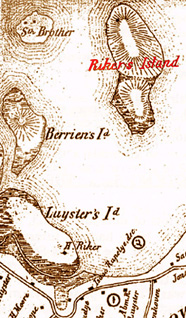
XXX
|
|
Detail from 1852 map on Page 48 of The Rikers.
|
| Bishop Nutt, in his The Rikers book quotes Henry I. Hazelton's Boroughs of Brooklyn and Queens (vol. 2, p. 1025; 1925) as to Hewletts on what became Rikers Island:
"The first Hewlett settlement, it is believed, was on Riker’s Island, George lived there with his first wife, widow of Guisbert Riker, until the Indians becoming troublesome they made their escape one afternoon. The redmen the following day destroyed their home and all their belongings. They settled at Hempstead."
The author of The Rikers theorizes:
There is [a] possibility, still speculation, for George [Hewlett] settling on the island with Gysbert’s widow: perhaps Gysbert had gone there first and had started settling a pioneer farm before dying and leaving his widow whose new husband joined her there. . . . Abraham’s interest in the island may have derived from its having earlier been his relative’s settled farm, albeit a squatter’s farm, which he took steps to acquire after Gysbert’s successors were forced from it.
The bishop, himself in the 11th generation from the progenitor Abraham Rijcken vanLent, indicates in The Rikers that family members farmed the island themselves -- raising hay, corn, flax, and some livestock -- until the late 1840s. Henry Riker of the 6th generation was last of the line to live on the island. Later it was leased. In the 1850s, ownership of the island passed out of family hands entirely.
XXX
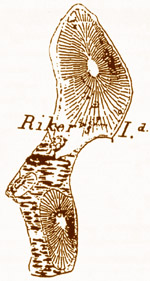
XXX
|
|
Rikers Island sketch from 1837 map in James Riker's 1852 The Annals of Newtown on Page 27 of Edgar Alan Nutt's book..
|
|
Civil War Letter
During the Civil War, the island served as military camp for Union forces. While little farming likely took place during that period, at least one soldier encamped there -- John F. Potter of the 76th NYS Volunteers -- in a Feb. 13, 1862 letter to his homeown paper, included a description of the place and its indigenous wild life:
"It comprises about 90 acres of good soil, an orchard, and one dilapidated old house, hired by one Harry, who keeps inside of it a bar and a family, the number of representatives deponent knoweth not.
"Its climate is miserable cold, uncomfortable, disagreeable and lonely, and its chief productions, so far as I was able to practically demonstrate, were oysters, clams, salt water . . . In summer time, it wo'd be a capital place to recreate, to hunt and fish, as wild ducks abound delightly, and fish can be obtained in any quantity, but it's not exactly the spot for delicate wildlife in the tedious winter time, as the wind whistles Yankee Doodle . . . ."
Produce, Fertilizer, & DOC's Rikers Island
Rikers Island was purchased by the NYC in 1884 for use by the Department of Public Charities and Correction. The acquisition occurred during the mayoral administration of Franklin Edson, who in his youth had worked on a farm during summer months and who had later founded a successful grain and produce company, serving at various times as president of the New York Produce Exchange.
XXX

XXX
|
|
First NYC DOC Commissioner: Robert J. Wright
|
| Edson played a key early role in developments leading construction of the Croton Acquaduct and acquisition of Westchester woodlands and farms that became the major Bronx parklands.
One may speculate whether the mayor's argicultural backguard figured at all as a factor in the Rikers Island acquisition and development. But the fact is that initially those 90+ aces in the East River became the city's Municipal Farm aka prison farm colony.
Nine years later landfill operations began with the dumping of the city's garbage, trash and debris. The dumpings were in full swing in 1895/6 when the dual agency's component parts -- Correction and Public Charities -- split into separate and organizationally distinct departments. Robert J. Wright, one of the three commissioners who had run the Department of Public Charities and Correction, became the new Department of Correction's first commissioner. Interestingly, from the perspective of this Rikers Island farm presentation, Wright was partner in the fertilizer firm of Kane & Wright.
Rikers Island: 1 of 6 DOC Farms
The 1922 annual report of Correction Commissioner James A. Hamiltion provides interesting insights into Rikers Island operations more than a decade prior to the opening of its penitentiary complex in the mid-1930s.
In the Directory of DOC bureaus and institutions on Pages 5 and 6, it is listed as "Municipal Farm, Rikers Island." In a Food Production table on Page 10, Rikers stats are given for yields of asparagus, lima beans, beets, cabbage, carrots, celery, corn, leeks, lettuce, onions, parsnips, pork, radishes, rhubarb, Swiss chard, tomatoes, turnips, parsley, and sprouts.
XXX
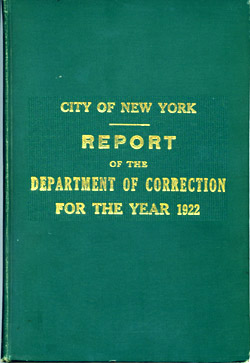
XXX
|
|
1922 DOC annual report front cove.
|
| In a Forage Production table on Page 11 appear stats for cattle beets, field corn and soy beans. Worth noting is that the food and forage production tables also include statistical columns for farming operations at five other DOC locations:
- two in NYC: the NY County Penitentiary on Welfare (now called Roosevelt) Island and the Reformatory Prison on Hart Island; and
- three in Orange County: the NYC Reformatory at New Hampton, the NYC Women's Farm Colony at Greycourt, and the Dairy Farm at Warwick.
Under the subhead "Farms" on Page 13, the report notes:
"From The Municipal Farm, Rikers Island, the quality and quantity [of vegetables] produced were better and greater than ever. Soil conditions have been greatly inproved by delivery of manure from the Department of Street Cleaning . . . . The pork received from hogs raised at Riker's Island and New Hampton Farm was of good quality. . . ."
A Half-Dozen Barricks-like Dorms
On Pages 14 and 15, the Bureau of Construction and Repairs reported under the subhead "Municipal Farm, Riker's Island," these items of "special work of more than ordinary importance:
- "Installation of complete moving picture equipment, also telephones between the doctor's residence and main office.
- "Erection of new piggery building under construction.
- "Addition and alternation to shop building nearing completion.
- "Erection of new steel smoke stack for steam boiler under main kitchen.
- "Installation of new plumbing fixtures and water supply pipes and cement flooring in toilet rooms of doritory Nos. 5 and 6; also new tubes in steam boilers.
- "Renovating and painting main office, mess hall, dormitories Nos. 1, 2, 3 and 4, exterior of doctor's residence and employees' cottage.
- "Installation of new feeders supllying electric current to dormitory No. 5."
XXX
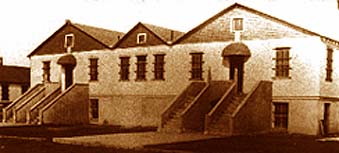
XXX
|
|
Rikers Island Municipal Farm dorms circa 1910s/1920s.
|
| Page 27 describes the addition to a Municipal Farm shop building on Rikers Island thusly:
"The necessary addition to the shop building was erected on East Side of building. The different shops (Plumbing, Carpenter, Tinsmith, Blacksmith, Electrician's, Machinist, Shoe Repairing) are now in one building. With this increased floor space we have room to make necessary repairs to farm machinery (culivators, plows, tractors, etc.) during winter months."
Pages 32 and 33 feature reports by the Rt. Rev. George T. Donlin, the Rev. Annesley T. Young, and the Rev. Harry T. Lewis, respectively the Catholic, Protestant and Jewish chaplains, about their work on Rikers Island. Described were religious services, distribution of reading material, visits to the hospital and setting up post-released support for the inmate wanting help -- "clothing . . . work, shelter and food until he gets on his feet . . . ."
The Bureau of Education and Recreation on Page 34 and 36 reports under Municipal Farm, Rikers Island subheads:
"In summer, inmates play baseball on Sunday afternoons. Motion Pictures are shown twice a week during summer and on Sunday afternoons and holidays during winter. On Thanksgiving, Christmas aand New Year's Day entertainments were given by inmates. . .
"We have about 900 books in the library. Rev. Annesley T. Young supplied a number of magazines."
Rikers Farm, Addict Hospital Inmate Counts
The Bureau of Medicine and Surgery includes on Pages 41 and 42 a report by the Municipal Farm's resident physician Dr. Stuart N. MacVean who notes:
"The drug addict hospital located at the Municipal Farm received and treated 1,898 inmates. Approximately 30 %, or 500 inmates were repeaters and about 10 % of the 500 repeaters returned for a third treatment.
XXX
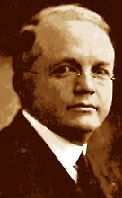
XXX
|
|
James A. Hamilton, Correction Commissioner 1918-1922
|
| "The daily average number of patients in the hospital was 50 patients treated at the clinic were 2,000. The average number treated daily was 6. . . . The transfer of inmates to other institutions for treatment, operations, etc. was ... To Hart's Island Tuberculosis Hospital, 45, and to [Welfare Island] Penitentiary Hospital, 117. . .
"During the year the inmate population has enjoyed good health, with only two deaths at this institution. The sanitary conditions have been good."
Serving the last of his four years as DOC Commissioner, Hamilton used the 1922 report to list on Pages 45 through 49 his administration's "accomplishments." Among them he listed for the Municipal Farm "altering Dormitories Nos. 1 and 2" and "erecting a grand stand seating 600."
Pages 50 through 82 are devoted to various statistical tables. The "Daily Average of Inmates at Each Institution For 1922" table on Page 53 lists the "Municipal Farm, Rikers I." daily average as 401. If, as Dr. MacVean reports, the addict hospital averaged 50 patients daily, then the Rikers Island inmate population not classified as addict hospital patients averaged 351. To place that in perspective, note that the table for departmental (all institutions) statistics puts the total average daily inmate population in 1922 as 4,219.
Not clear is how many of the island's inmates not classified as patients of the addict hospital were former patients discharged as no longer requiring hospitalization.
Below is an image of a table from Page 77 setting forth Rikers Island per capita operating costs. A red line has been added to the image beneath the word "farm" for emphasis.
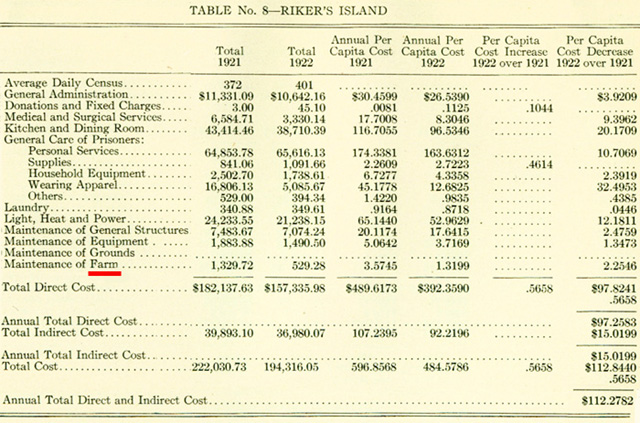
|

